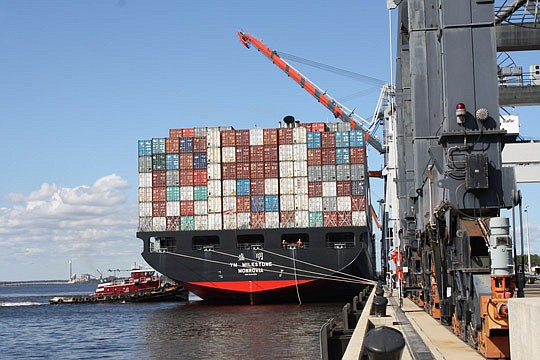
Despite requests for the Jacksonville Port Authority to pursue dredging the St. Johns River to a channel depth of 50 feet, Hanjin Shipping Co. is still on board to make Jacksonville its first dedicated U.S. operation outside the West Coast.
The JPA board voted unanimously Monday to pursue a dredging depth from 40 feet now to 47 feet, more than the 45-foot depth recommended by the U.S. Army Corps of Engineers.
The port reached an agreement with representatives of the Hanjin of Seoul, South Korea, in December 2008 on a 30-year lease agreement, which included the construction of a 90-acre container facility at the Dames Point Marine Terminal.
The container terminal was estimated to cost about $300 million and will be designed, permitted, financed and constructed by the port.
It includes two berths to accommodate post-Panamax vessels — classified as ships that do not currently fit in the Panama Canal — and increased container traffic along the East Coast.
The terminal capacity is designed to handle more than 800,000 20-foot-equivalent container units, or TEUs, a year.
In January 2011, the authority and Hanjin agreed to amend the timeline for construction of the new terminal to coincide with the deepening of the harbor. Hanjin expects the terminal to be operational by 2017, according to its website.
Initially, Hanjin wanted guarantees the port would strongly pursue a depth of 50 feet to enable its large post-Panamax ships to dock in Jacksonville and ensure the economic feasibility of the move to Jacksonville, but the company later agreed that as long as the port had a depth similar to its nearest competitor, it would be suitable for operation.
The port in Savannah, Ga., is at 47 feet.
"The commitment of Hanjin to our port is as strong as it has ever been and we will be submitting a letter of support from Hanjin, along with other letters from businesses at the port, supporting our efforts in pursuing deep water," said Roy Schleicher, port interim CEO.
"It's not just the port saying, 'We need deeper water.' It's all the business that we serve and are affected by development of the port that are asking for this as well," said Schleicher.
The amended agreement is expected to create more than 5,600 private sector jobs in Jacksonville and support operations in trucking, distribution and related services. The port estimates the terminal will generate nearly $1 billion in annual economic impact.
The Hanjin fleet includes about 200 containerships and bulk and liquefied natural gas carriers.
"If we ever want to be considered as a leader in the shipping industry on the East Coast, we have to make these kinds of decisions, generational decisions," Schleicher said, referring to the decision to pursue the 47-foot depth.
Dennis Kelly, TraPac regional vice president and general manager, agreed that a deeper depth for Jacksonville's harbor was necessary, but said he also understood the decision means more competition for the shipping business.
TraPac opened a 158-acre container yard and two vessel berths at the port's Dames Point Marine Terminal in 2009 as the port pursued the Asian shipping market.
"A deep-water project is definitely a necessity for Jacksonville to stay competitive in the international shipping business, trade. The Florida ports have missed out on opportunities because, until the last two years, a majority of the (U.S.) trade business was coming through other ports in the country," said Kelly.
He recognized the regional efforts to support Florida ports by Gov. Rick Scott and national efforts by President Barrack Obama's "We Can't Wait Initiative" that expedited the process to expand five U.S. ports, including Jacksonville's.
"Though deep water would help us as well as our competition, Hanjin, competition is good for business," said Kelly.
The next step for the harbor-deepening project will be for the Corps to review its report, which will include the cost-to-benefit analysis of deepening the port at each level up to 50 feet and the environmental modeling that was used to determine the effects the deepening would have on the region.
After the review is completed in April, the Corps plans to release the information for public review before sending it to Assistant Secretary of the Army, Civil Works, Jo-Ellen Darcy, for consideration of approval.
@photojoe71
(904) 356-2466